How To Create A Sharepoint Server
Step-by-Step Guide To Setting Up SharePoint Server 2016
![]()

On August 25th (Vietnam time), Microsoft introduced a SharePoint Server 2016 Preview for public download. You can now access the download here for 6 months using the following trial product key: NQTMW-K63MQ-39G6H-B2CH9-FRDWJ
I just download the preview and set it up using the following: Azure A3 virtual machine, 7GB, 285GB hard disk. It's lower than Microsoft's recommended hardware requirements (see https://technet.microsoft.com/library/cc262485(office.15).aspx), but I wanted to try to host a single installation (DB + SharePoint) in one standalone server to see how it performs.
For my installation, my server will host SharePoint Server 2016 with SQL Server 2014 Enterprise SP1. In this article, I will introduce in detail step-by-step installation instructions to benefit those who are new to SharePoint.
After downloading the .iso file, right click and mount it to a virtual CV.
Step 1: Install Prerequisite Tools

Go to the directory where you have your installation files. Double click Setup File to start SharePoint Server 2016 Preview installer. The SharePoint 2016 setup screen will appear as shown below:
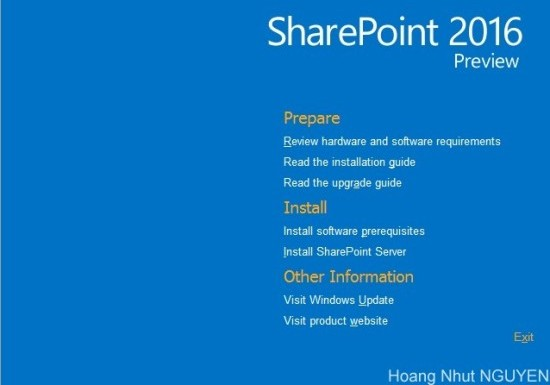
Click on Install Software Prerequisites to start Prerequisite Tools installer, or you can find the Prerequisite.exe file and run it as an Admin.
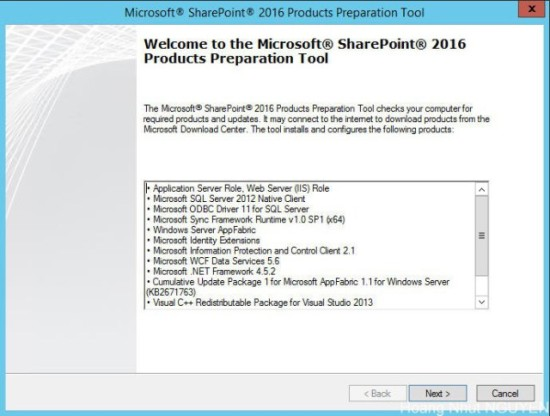
There are two options for you to install prerequisite products:
Prerequisite Tools Online Installation: This method requires your server to be connect to the Internet. In the following Microsoft SharePoint 2016 Products Preparation Tool screen, you will be able to see the complete list of the prerequisite products for installation. Click on Next to continue. On the License Terms for Software Products screen, read the license terms carefully and select the check box that states your acceptance of the license terms. Click Next to continue. The Prerequisite Installation process will begin.
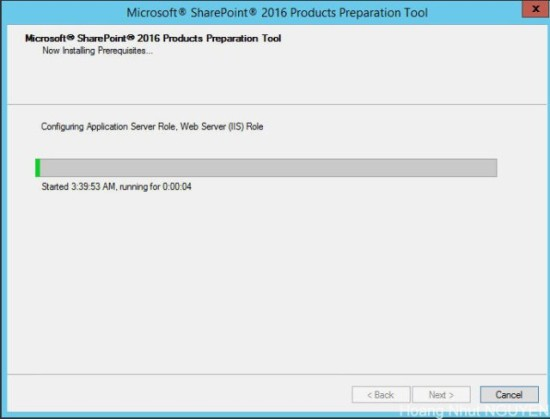
You may be asked to restart the server to continue. Click Finish to continue. Once you have restarted the server, the Prerequisite Installer will automatically resume the installation process.
Prerequisite Tools Offline Installation: You need to configure Roles and Features on Windows Server 2012 R2. To do so, open an elevated PowerShell prompt (i.e. Run as Administrator) and execute the following:
Import-Module ServerManager Add-WindowsFeature Net-Framework-Features,Web-Server,Web-WebServer,Web-Common-Http,Web-Static-Content,Web-Default-Doc,Web-Dir-Browsing,Web-Http-Errors,Web-App-Dev,Web-Asp-Net,Web-Net-Ext,Web-ISAPI-Ext,Web-ISAPI-Filter,Web-Health,Web-Http-Logging,Web-Log-Libraries,Web-Request-Monitor,Web-Http-Tracing,Web-Security,Web-Basic-Auth,Web-Windows-Auth,Web-Filtering,Web-Digest-Auth,Web-Performance,Web-Stat-Compression,Web-Dyn-Compression,Web-Mgmt-Tools,Web-Mgmt-Console,Web-Mgmt-Compat,Web-Metabase,Application-Server,AS-Web-Support,AS-TCP-Port-Sharing,AS-WAS-Support, AS-HTTP-Activation,AS-TCP-Activation,AS-Named-Pipes,AS-Net-Framework,WAS,WAS-Process-Model,WAS-NET-Environment,WAS-Config-APIs,Web-Lgcy-Scripting,Windows-Identity-Foundation,Server-Media-Foundation,Xps-Viewer –Source
– where you have mounted the Windows Server 2012 installation media (ISO) to, example: "D:\sources\sxs".
Your server will require a reboot after running this PowerShell code.
Next, download the following SharePoint 2016 Prerequisite tools from the Microsoft Download Center for Offline Installation:
- Microsoft SQL Server 2012 Native Client
- Microsoft ODBC Driver 11 for SQL Server
- Microsoft Sync Framework Runtime v1.0 SP1 (x64)
- Windows Server AppFabric
- Microsoft Identity Extensions
- Microsoft Information Protection and Control Client 2.1
- Microsoft WCF Data Services 5.6
- Cumulative Update Package 1 for Microsoft AppFabric 1.1 for Windows Server (KB2671763)
- Microsoft .NET Framework 4.5.2 v
- Update for Microsoft .NET Framework to disable RC4 in Transport Layer Security (KB2898850)
- Visual C++ Redistributable Package for Visual Studio 2013
After installing the Prerequisite tools, reboot the server. All the prerequisites should now be installed and you should be able to install SharePoint 2013.
Step 2: Install SharePoint Server 2016

Go to the directory where you have your installation files. Find the setup.exe file and run as Administrator. On the "Enter Your Product Key" screen, fill your product key field (NQTMW-K63MQ-39G6H-B2CH9-FRDWJ), then press Continue.
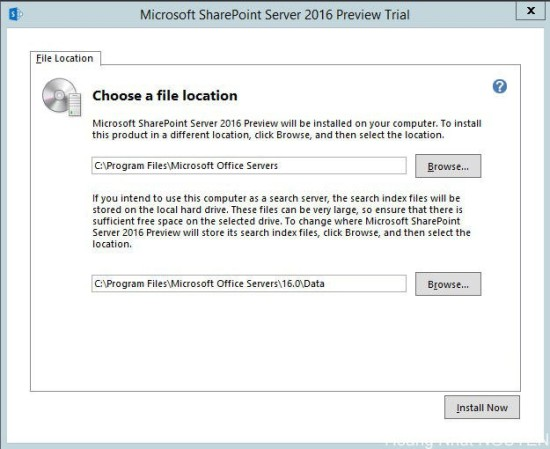
On the "Choose a File Location" screen, verify the installation path for storing the system files. Note that the 16 hive folder in SharePoint 2016 was changed from C:\Program Files\Common Files\microsoft shared\Web Server Extensions\15\ to C:\Program Files\Microsoft Office Servers\16.0\Data.
Click Install to start installation.
Step 3: Finish SharePoint Products Configuration Wizard
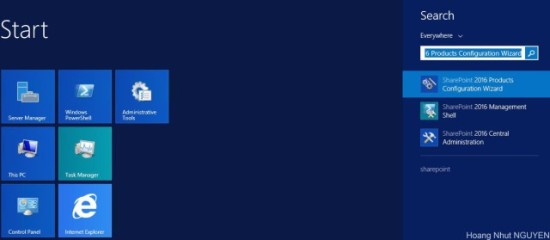
Once the installation is complete, on the "Run Configuration Wizard" screen, check the "Run the SharePoint Products Configuration Wizard Now" box, then click Close. In some cases, you can run "SharePoint Products Configuration Wizard" from the Start menu to begin configuring SharePoint 2016 if it hasn't already begun.
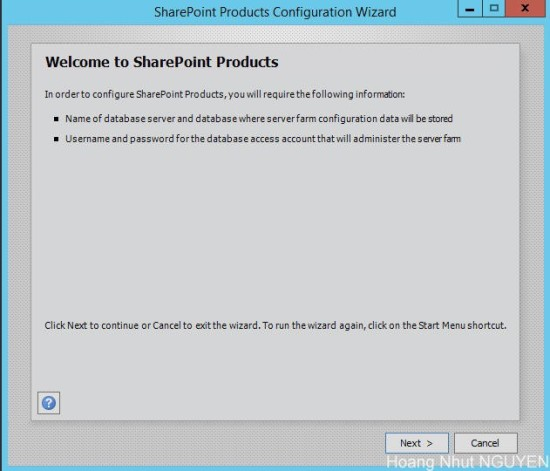
The "Welcome to SharePoint Products" screen will appear. Click Next to continue.

Click Yes on the warning box. On the following screen, check the "Create a New Server Farm" radio button, then click Next.
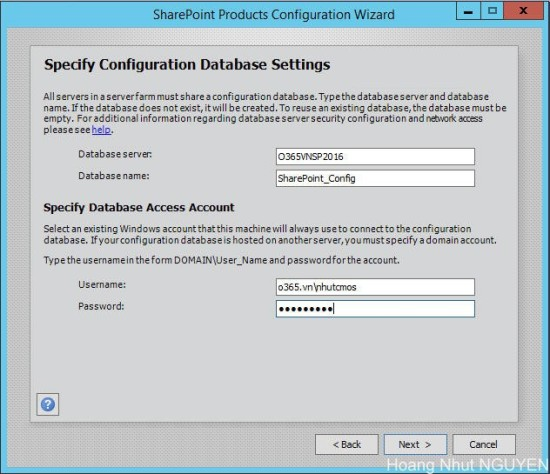
On the "Specify Configuration Database Settings" screen, fill in corresponding "Database Server" and "Database Name" information. With the "Database Access Account," you must input username and password of the domain account. SharePoint will not allow local accounts for SharePoint farm installations.
However, there are some tips for setting up SharePoint farm with a local machine. The trick is to use the Powershell command New-SPConfigurationDatabase to create the config DB; you can specify the local account here, which I did successfully.
New-SPConfigurationDatabase -DatabaseName "SharePoint_ConfigDB" -DatabaseServer "[InputYourDatabaseServerName]" -Passphrase (ConvertTo-SecureString "[InputYourPassPhase]" -AsPlainText -force) -LocalServerRole SingleServer -FarmCredentials (Get-Credential).
Note that, in SharePoint 2016, the New-SPConfigurationDatabase command uses ServerRoleOptional to define which kind of server role you want to deploy. Once this is done, you can go back to the SharePoint Products Configuration Wizard, and this time it will have the default option "Connect To An Existing Farm" checked. A few additional clicks and you should be ready to explore the new SharePoint 2016.

Fill "Passphrase" on the following screen, remembering to note the passphrase for later use.
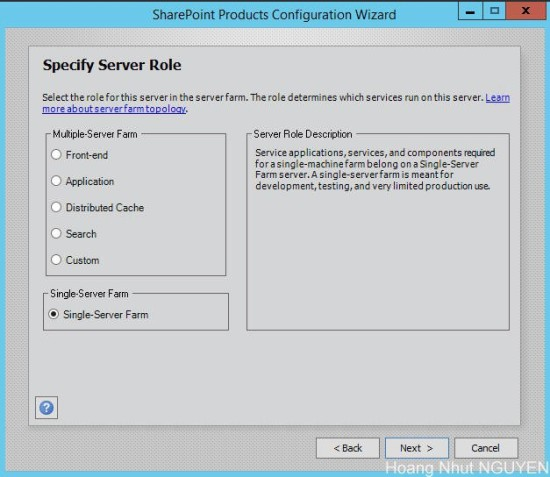
On "Specify Server Role," select what kind of server role you want to use to deploy this server to the farm. In this deployment, I chose Single Server Farm for testing and development purposes. Select "Single-Server Farm" and click Next.

On the following screen, you can check the "Specify Port Number" box to specify the port number of the central admin site; if left unselected, the port number will be a default number. Check the "NTLM" radio button, then click Next to continue.

Click Next to preview the configuration summary.
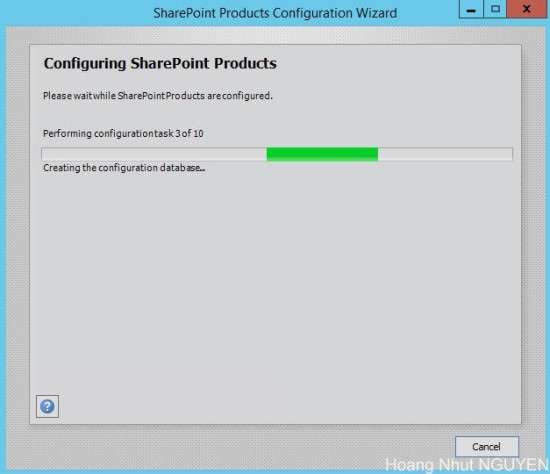
Click Next. The configuration process will begin.
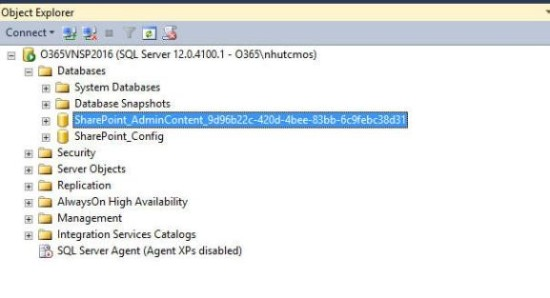
From the database server, check that two databases have been made. Note that in the previous version, only one configuration database was created; using SharePoint 2016, another database name (SharePoint_AdminContent_GUIID) is created.
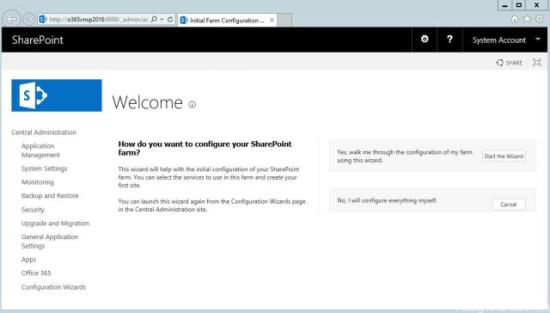
Once the Configuration process is complete, the following screen will be shown. Click Finish to continue.
Test the Services application by running "SharePoint 2016 Central Administrator." Use the setup account to log on and access the Central Administrator site. The system will ask you to run the service configuration wizard page, however I suggest you configure them manually.
Once you finish the SharePoint Server 2016 installation, you should see the Central Administration page.
Step 4: Create Test Site Collection

Return to Central Admin, then access Manage Web Application.

From the "Web Application" list screen, click New to open the "Create Web Application" page. Fill in the necessary information and click OK.
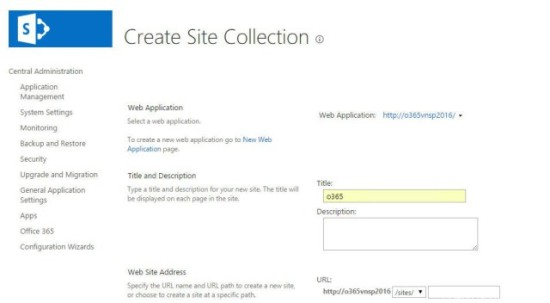
After creating the new web application in port 80. Create a site collection.and fill in the necessary information.
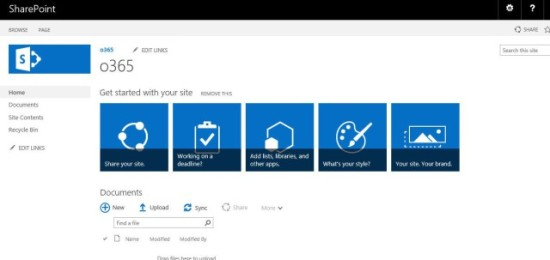
The finished test site collection should appear as below
Conclusion

SharePoint Server 2016 in look and feel is very similar to SharePoint 2013. Recently announced by Microsoft, SharePoint 2016 boasts improved architecture to support Cloud solution and hybrid deployment.Once I finished installation on 7GB RAM, SharePoint 2016 works a bit slowly, as was expected.
Source: Hoang Nhut Nguyen, Niftit-er
How To Create A Sharepoint Server
Source: https://medium.com/niftit-sharepoint-blog/step-by-step-guide-to-setting-up-sharepoint-server-2016-32c22555e545
Posted by: pullenmrseach.blogspot.com

0 Response to "How To Create A Sharepoint Server"
Post a Comment